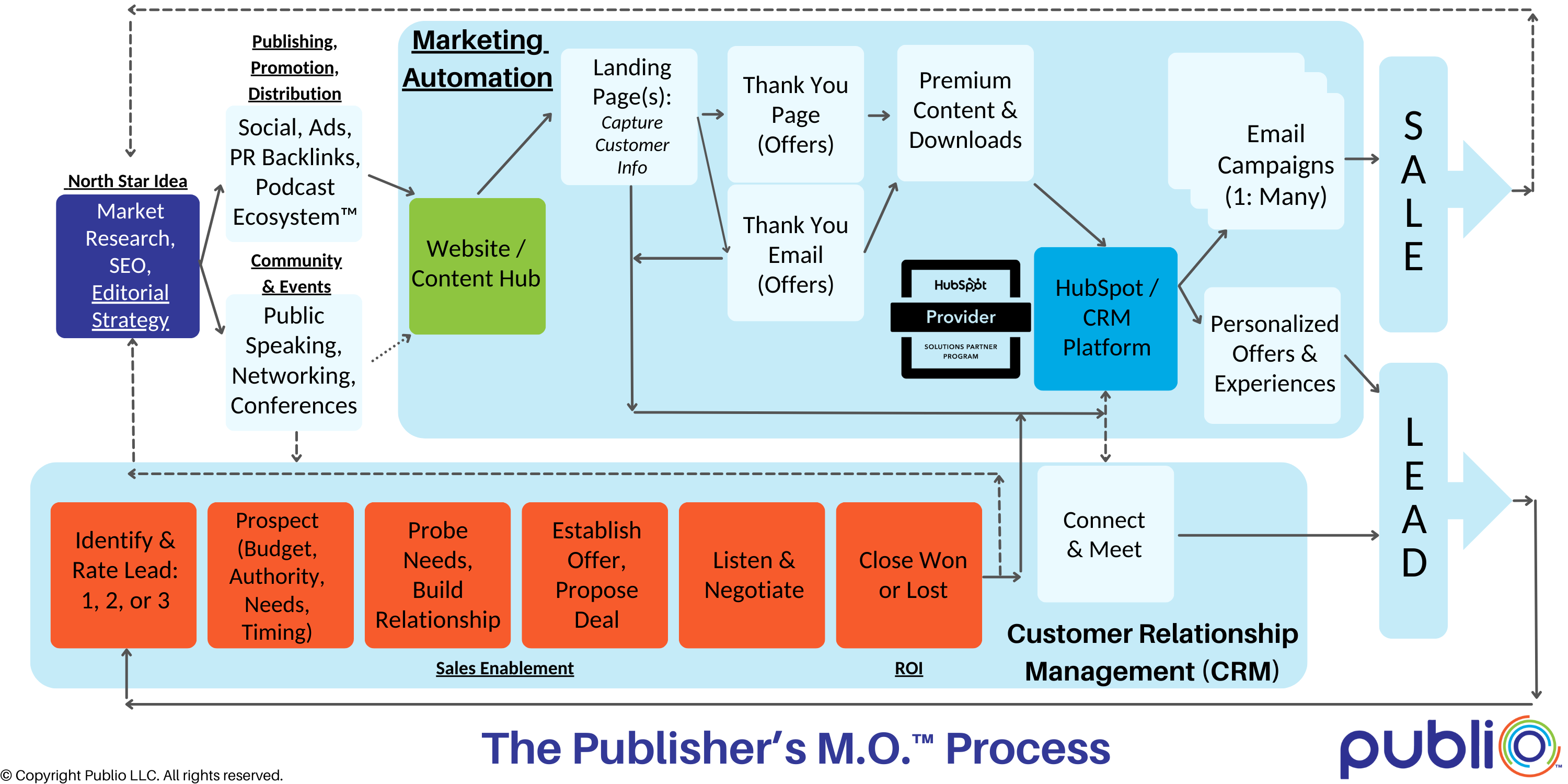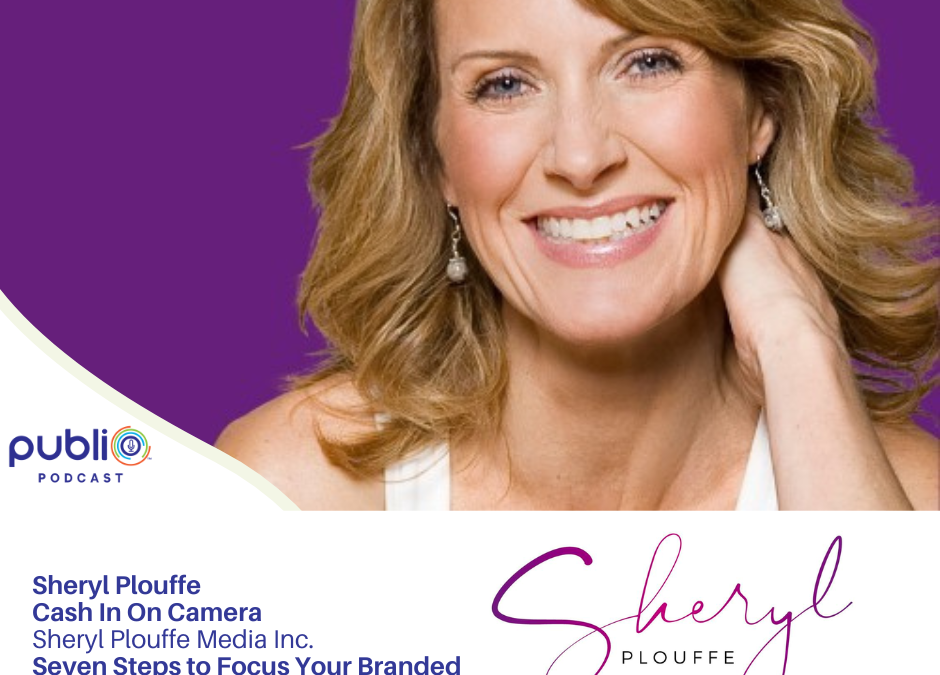Your branded Content Hub is central to your marketing strategy, but does it actually bring in leads and sales? Sheryl Plouffe, a leader in media and marketing strategy for six and seven-figure businesses, put this question before Publio founder and CEO Keith Reynolds on her Cash In On Camera podcast.
“Content costs money and time,” Reynolds said, “so it should produce sales that justify the spend. People struggle with content because they don’t see the return on investment.”
That is the value of a branded Content Hub. A branded Content Hub is your channel to your customers and can serve all kinds of functional purposes to make doing business easier for your various stakeholders. The key is to produce the content they need and care about in a strategic way to serve your business needs.
“Publishing content is nothing new,” Plouffe added, ”I like how you outline the Publisher’s M.O. in a seven-step process so that things happen in the right order.”
“Content costs money, so it should produce sales that justify the spend. People struggle with content because they don’t see the return on investment.”
Publio’s Publisher’s M.O.™ is your modus operandi to implement a branded Content Hub strategy for your company.
Reynolds and Plouffe walk through the Publisher’s M.O.’s seven-step process to create your marketing strategy and implement a plan to achieve your content marketing goals.
Step 1: Your North Star Idea Communicates Your Branded Content Hub’s Value Proposition
Sometimes, your North Star Idea is captured in a metaphor. Sometimes it’s a very specific statement. Think about the people on the other side of the glass. You have eight seconds or less to capture their attention.
“Customers understand a company through its people, values and culture,” Reynolds explained. “Your North Star Idea is exactly that: It can be the name of your branded Content Hub or the tagline of your company.
“I know a CEO who was building a coaching organization,” Reynolds added, “so the coaching metaphor bled through everything they did, even though they are a technology company.”
Step 2: Editorial Strategy for Your Branded Content Hub
Your editorial strategy defines how you will execute on your North Star Idea. It is guided by research on markets, customers and SEO. Use these components to create an editorial calendar for content such as videos, blogs and social media posts. It’s a management function where you schedule content and assign specific tasks to your team members.
“Plan your content around buying cycles, holidays, trade shows and themes in your business,” Reynolds suggested. “Your editorial calendar is the best way to execute your North Star Idea.”
Step 3: Publish, Promote and Distribute Your Content
Your content is defined and created. Now it’s time to place your content into the hands of people who will read it, watch it, share it and associate it with your brand.
The distribution strategy is a hub-and-spoke model with your Content Hub at the center. The spokes are activities such as social media posts, media pitches, and specific content like white papers or webinars that draw people to your Content Hub.
“It’s having the awareness of where your ideal clients are spending their time,” Plouffe observed.
Secure interviews that feature your senior managers and external influencers with the trade press, websites that report on your industry, as well as partner companies.
“Backlinks from these sites build authority and trust among search engines – and your audience,” Reynolds added.
Step 4: Community and Events
In many ways, this is a subset of step 3 – distribution – but community and events are your real-life space where you connect and build relationships with your audience. Trade shows, customer events and community sponsorships are important enough to be counted separately.
“Eighty percent of your new business comes from getting out shaking hands, exchanging business cards, prospecting and networking,” Reynolds said, referring to the 80/20 rule.
These events are also a place where you find stories.
“When you meet somebody, nobody wants to talk to a salesperson, but everybody wants to be on your blog, or be interviewed on your podcast,” Reynolds continued. “Not only are you looking for customers, you’re also looking for people to interview or who can share what news that helps build your brand. So flip the switch and go out into that community.”
Step 5: Marketing Automation

“It’s the only way you’ll be able to run any Content Marketing campaign,” Reynolds said. “Not only does automation help you scale and manage the sheer number of people that interact with, it also gives you the reporting dashboard to improve your content or distribution channels in real time.”
“[Automation] is tweaking and tweaking and continuing to go on,” Plouffe observed. “If you want to grow and scale your operation, you will have to bring in some technology. But the nice thing is that a lot of these tools are easy to learn and use.”
“Use an engineered sales and marketing system,” Reynolds said. “These systems deal with the feedback loop. The purpose of the dashboard is to give you that feedback so that you can take what you did and maybe hit 75 percent of your goal on your first try, and get it to 80% on the next and 90% out of the next. “It’s all about continuous improvement.”
“The money you spend on automation gives you arms and legs,” Reynolds added. “Automation is there to enable you and give you information. If the data tells you you’re on the right track, then the automation will drive your ROI model.”
Step 6: Your Sales Model
If you don’t connect your Content Hub to your sales efforts, then why are you producing content at all? This step is for the people who have P&L responsibility.
What are you going to ask for when somebody watches your video or reads your blog? What’s the next step?
“If you have one salesperson or five salespeople or a hundred salespeople, you have to train them,” Reynolds explained. “You cannot expect somebody whose life is all about finding new customers and expect them to be media experts.
You have to teach them how to share information. When a prospect comes in at the top of the marketing funnel, what do you give them that will help the salesperson move the prospect down the funnel? Is it an ROI calculator? A white paper? Different materials get shared at different times, so your sales force has to be proficient in the technology, and know what to do to engage their prospects.
Step 7: Your Branded Content Hub’s Return on Investment (ROI)
Companies that already have $1 million or more in sales already know which channels their sales come from. Your ROI model looks at where you’re spending money, how that affects how your web traffic becomes leads or opportunities for sales. If you invest $10,000 in your marketing, can you expect to get three or four times back from that?
“The ROI model can show you what’s working and what’s not,” Reynolds pointed out. “It helps you to plan from a CEO’s or general manager’s perspective. The model allows the marketing department to manage its risks.”
The Publisher’s M.O. is simply a means, or methodology, that outlines how you know what you want to do and how to go about doing it. Each of these seven steps may seem obvious, but they are very often are ignored or skipped in the rush to get things done.
That’s why some publishers fail; it’s why marketing managers scratch their heads and wonder why no one is getting the message, or why results are lagging. Success is built on strategy, culture and teamwork. The Publisher’s M.O.is a system that guides your team helps you consistently produce and promote relevant content that will reach your audience.
Download a Free ROI Calculator for Your Branded Content Hub
Publio has developed an ROI calculator to help understand the risks and rewards of a Content Hub. It’s free, and we will give you a free one-hour consultation to help you get started.
Need more information? Read “Content Marketers Need an ROI Calculator: Here’s a Free One.”
Think Like a Publisher to Grow Your Business
Your biggest challenges to success are lack of a content strategy, and not enough resources to produce content. Our easy “seven buckets” approach will keep your team focused on results as you make progress.
Introducing the Publisher’s M.O.™ Generate ROI with content marketing in the age of digital disruption. The Publisher’s M.O is your modus operandi to implement a marketing strategy for your company, and a development experience for your team. Our method helps brand teams, agencies and entrepreneurs create content that will capture new leads for your sales funnel.
We wrote a book about it!
Read “The New Content Culture: Think Like a Publisher to Grow Your Business.”
How Publio Can Help Your Company
Publio brings a data-driven perspective to technology, finance, and professional services firms to open doors, qualify leads and get sales appointments. As a Fractional CCMO, Publio specializes in helping clients firms differentiate their offerings and create content that stands apart from their competitors. We use today’s cloud and AI technologies to deploy targeted media, generate new business and provide an excellent customer experience. We guide clients through our signature Publisher’s M.O.™ methodology to design and implement a marketing strategy and plan that leads to sustainable results and ROI.
Curious to learn how Publio can help your business? Schedule a free consultation with us today!

